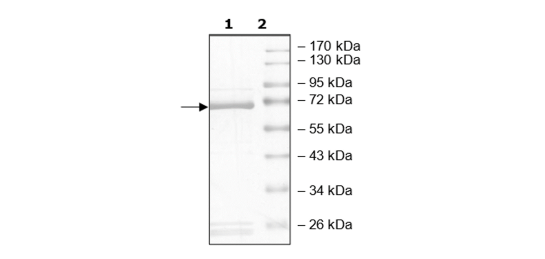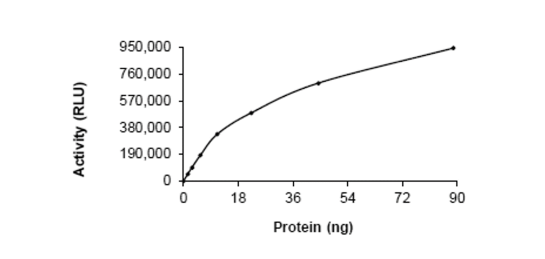FGFR3 (CD333), GST-tag Recombinant
Catalog #
40212
$410
*
●
●
Purchase
Description
Recombinant human FGFR3 (fibroblast growth factor receptor 3), encompassing amino acids 397-end. This construct contains an N-terminal GST-tag. The recombinant protein was affinity purified and is active.
●
Synonyms
ACH, CEK2, JTK4, CD333, HSFGFR3E, FGFR-3
●
Product Data Gallery
Product Info
Storage and Usage
Citations
Species
Human
Construct
FGFR3 (GST-397-end)
Host Species/Expression System
Sf9 insect cells
Purity
≥90%
Format
Aqueous buffer solution
Formulation
50 mM Tris-HCl, pH 7.5, 150 mM NaCl, 10 mM Glutathione, 0.1 mM EDTA, 0.25 mM DTT, 0.1 mM PMSF, and 25% glycerol
MW
73 kDa
Amino Acids
397–end
Specific Activity
112 pmol/min/µg
Genbank #
NM_000142
UniProt #
P22607
Background
Fibroblast growth factor receptor 3 (FGFR3) is part of a family of fibroblast growth factor receptors that share similar structures and functions. FGFR3 plays a role in several important cellular processes, including regulation of cell growth and division, determination of cell fate, formation of blood vessels, wound healing and embryo development (1). FGFR3 is involved in the development and maintenance of bone and brain tissue. Mutations in FGFR3 have been implicated in causing bladder cancer, cancer of white blood cells (multiple myeloma) and cervical cancer (2).
References
1. Chen, L. and Deng, C.X. Roles of FGF signaling in skeletal development and human genetic diseases. Front Biosci. 2005; 1(10):1961-1976.
2. Mhawech-Fauceglia, P. et al. 2006. FGFR3 and p53 protein expressions in patients with pTa and pT1 urothelial bladder cancer. Eur. J. Surg. Oncol. 2006; 32(2):231-237
2. Mhawech-Fauceglia, P. et al. 2006. FGFR3 and p53 protein expressions in patients with pTa and pT1 urothelial bladder cancer. Eur. J. Surg. Oncol. 2006; 32(2):231-237



